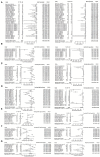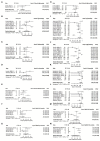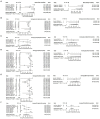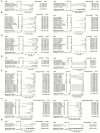Severe Acute Respiratory Syndrome Coronavirus 2 Diagnostic Tests for Border Screening During the Very Early Phase of Coronavirus Disease 2019 Pandemic: A Systematic Review and Meta-Analysis
- PMID: 35237618
- PMCID: PMC8882616
- DOI: 10.3389/fmed.2022.748522
Severe Acute Respiratory Syndrome Coronavirus 2 Diagnostic Tests for Border Screening During the Very Early Phase of Coronavirus Disease 2019 Pandemic: A Systematic Review and Meta-Analysis
Abstract
Diagnosis of severe acute respiratory syndrome coronavirus 2 (SARS-CoV-2) during border screening among returning residents and prioritized travelers during the early phase of a pandemic can reduce the risk of importation and transmission in the community. This study aimed to compare the accuracy of various SARS-CoV-2 diagnostics and assess their potential utility as border screening for infection and immunity. Systematic literature searches were conducted in six electronic databases for studies reporting SARS-CoV-2 diagnostics (up to April 30, 2020). Meta-analysis and methodological assessment were conducted for all included studies. The performance of the diagnostic tests was evaluated with pooled sensitivity, specificity, and their respective 95% confidence intervals. A total of 5,416 unique studies were identified and 95 studies (at least 29,785 patients/samples) were included. Nucleic acid amplification tests (NAAT) consistently outperformed all other diagnostic methods regardless of the selected viral genes with a pooled sensitivity of 98% and a pooled specificity of 99%. Point-of-care (POC) serology tests had moderately high pooled sensitivity (69%), albeit lower than laboratory-based serology tests (89%), but both had high pooled specificity (96-98%). Serology tests were more sensitive for sampling collected at ≥ 7 days than ≤ 7 days from the disease symptoms onset. POC NAAT and POC serology tests are suitable for detecting infection and immunity against the virus, respectively as border screening. Independent validation in each country is highly encouraged with the preferred choice of diagnostic tool/s.
Keywords: COVID-19; acute respiratory infection; diagnostic accuracy test; molecular test; sensitivity and specificity; serologic test; systematic review.
Copyright © 2022 Chua, Gwee, Wang, Gui and Pang.
Conflict of interest statement
The authors declare that the research was conducted in the absence of any commercial or financial relationships that could be construed as a potential conflict of interest.
Figures





Similar articles
-
Diagnostic accuracy of SARS-CoV-2 antigen test in the pediatric population: A systematic review and meta-analysis.Pediatr Neonatol. 2023 May;64(3):247-255. doi: 10.1016/j.pedneo.2022.07.012. Epub 2022 Oct 25. Pediatr Neonatol. 2023. PMID: 36344413 Free PMC article.
-
Thoracic imaging tests for the diagnosis of COVID-19.Cochrane Database Syst Rev. 2020 Sep 30;9:CD013639. doi: 10.1002/14651858.CD013639.pub2. Cochrane Database Syst Rev. 2020. Update in: Cochrane Database Syst Rev. 2020 Nov 26;11:CD013639. doi: 10.1002/14651858.CD013639.pub3. PMID: 32997361 Updated.
-
Diagnostic Accuracy of SARS-CoV-2 Antigen Tests for Community Transmission Screening: A Systematic Review and Meta-Analysis.Int J Environ Res Public Health. 2021 Oct 30;18(21):11451. doi: 10.3390/ijerph182111451. Int J Environ Res Public Health. 2021. PMID: 34769968 Free PMC article.
-
Evaluation of qualitative and semi-quantitative cut offs for rapid diagnostic lateral flow test in relation to serology for the detection of SARS-CoV-2 antibodies: findings of a prospective study.BMC Infect Dis. 2022 Oct 31;22(1):810. doi: 10.1186/s12879-022-07786-5. BMC Infect Dis. 2022. PMID: 36316641 Free PMC article.
-
Evaluation of performance of two SARS-CoV-2 Rapid IgM-IgG combined antibody tests on capillary whole blood samples from the fingertip.PLoS One. 2020 Sep 17;15(9):e0237694. doi: 10.1371/journal.pone.0237694. eCollection 2020. PLoS One. 2020. PMID: 32941461 Free PMC article.
Cited by
-
Clinical impact of rapid molecular diagnostic tests in patients presenting with viral respiratory symptoms: A systematic literature review.PLoS One. 2024 Jun 13;19(6):e0303560. doi: 10.1371/journal.pone.0303560. eCollection 2024. PLoS One. 2024. PMID: 38870136 Free PMC article.
References
-
- World Tourism Organization. 100% of Global Destinations Now have COVID-19 Travel Restrictions, UNWTO Reports. (2020). Available online at: https://www.unwto.org/news/covid-19-travel-restrictions (accessed January 24, 2021).
-
- The Straits Times. WHO Says Travel Bans Cannot Be Indefinite; Countries Must Fight Coronavirus. (2020). Available online at: https://www.straitstimes.com/world/who-says-covid-19-by-far-its-worst-gl... (accessed January 25, 2021)
-
- World Tourism Organization. International Tourism Down 70% As Travel Restrictions Impact All Regions. (2020). Available online at: https://www.unwto.org/news/international-tourism-down-70-as-travel-restr... (accessed January 25, 2021).
Publication types
LinkOut - more resources
Full Text Sources
Miscellaneous

